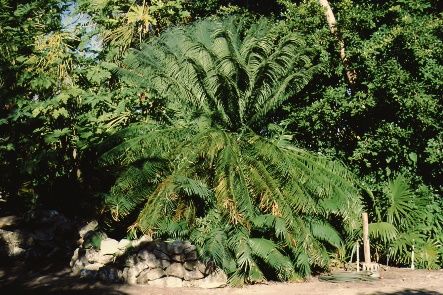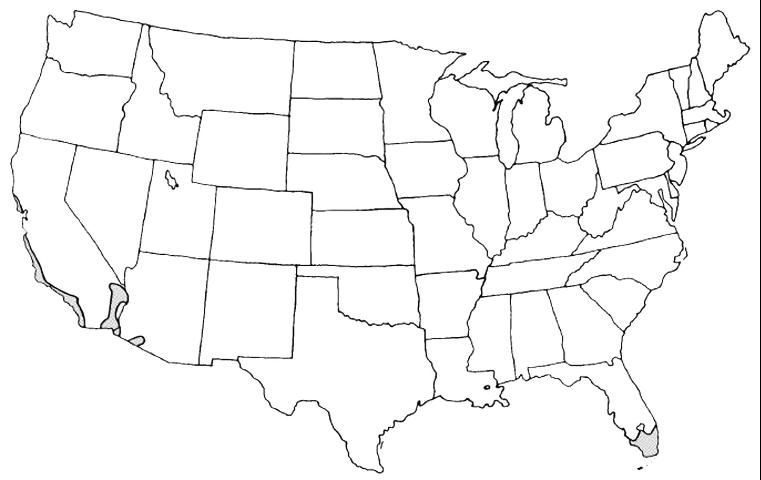Introduction
The palm-like queen sago has a short, dark brown, unbranching trunk topped with graceful, arching, medium green, feathery leaves, 6 to 8 feet long. Although slow-growing, queen sago is much prized for its light-textured tropical effect and easy care and makes an excellent lawn specimen or container plant for large areas. It is usually located as a specimen where it can be viewed from all sides but could be mass planted on 8 to 19 foot centers on a large scale industrial or commercial landscape. Many people plant it too close to a building, window or walkway and, unfortunately, need to remove leaves to allow for clearance.

Credit: Edward F. Gilman, UF/IFAS
General Information
Scientific name: Cycas circinalis
Pronunciation: SYE-kus sur-sin-NAL-liss
Common name(s): queen sago, sago palm
Family: Cycadaceae
Plant type: shrub
USDA hardiness zones: 10 through 11 (Figure 2)
Planting month for zone 10 and 11: year round
Origin: not native to North America
Invasive potential: not known to be invasive
Uses: border; accent; suitable for growing indoors
Availability: generally available in many areas within its hardiness range

Credit:
Description
Height: 6 to 15 feet
Spread: 8 to 12 feet
Plant habit: palm
Plant density: moderate
Growth rate: slow
Texture: fine
Foliage
Leaf arrangement: spiral
Leaf type: even-pinnately compound
Leaf margin: entire
Leaf shape: lanceolate
Leaf venation: none, or difficult to see
Leaf type and persistence: evergreen
Leaf blade length: 8 to 12 inches
Leaf color: green
Fall color: no fall color change
Fall characteristic: not showy
Flower
Flower color: no flowers
Flower characteristic: no flowers
Fruit
Fruit shape: elongated
Fruit length: 1 to 3 inches
Fruit cover: dry or hard
Fruit color: brown
Fruit characteristic: showy
Trunk and Branches
Trunk/bark/branches: can be trained to grow with a short, single trunk; usually with one stem/trunk; showy; typically multi-trunked or clumping stems
Current year stem/twig color: not applicable
Current year stem/twig thickness: not applicable
Culture
Light requirement: plant grows in part shade/part sun
Soil tolerances: slightly alkaline; clay; sand; acidic; loam
Drought tolerance: high
Soil salt tolerances: poor
Plant spacing: 36 to 60 inches
Other
Roots: usually not a problem
Winter interest: no special winter interest
Outstanding plant: plant has outstanding ornamental features and could be planted more
Pest resistance: long-term health usually not affected by pests
Use and Management
When given sufficient room to spread, queen sago performs very well in shade or full sun and needs only occasional watering once established. It is too large for many small landscapes. King sago would be a good substitute in a small residential landscape.
Plants are usually propagated by seed but can also be started by division of suckers.
Pests and Diseases
Scale can be a minor problem. Thrips can disfigure foliage.
Leaf-spotting diseases usually cause only minor problems.